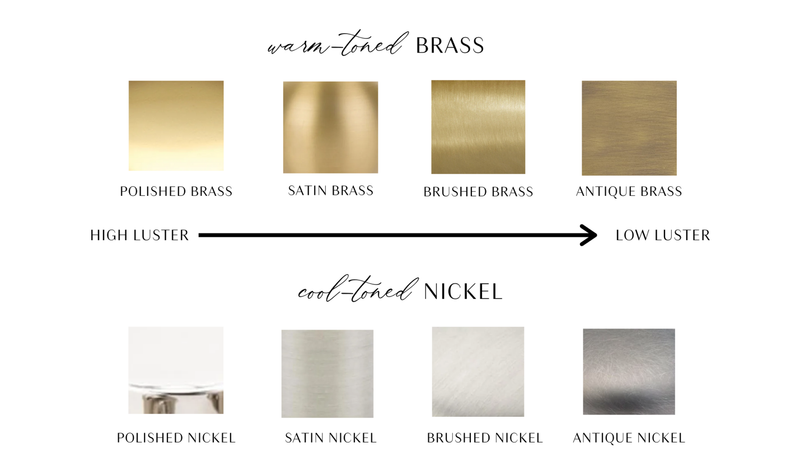
We wanted our first blog to answer the most frequently asked questions like: “Can you mix chrome and brushed nickel in a kitchen?” and “Can you mix brushed nickel and bronze?” or “Can you mix brushed nickel and polished nickel?” and “Can you mix brass and stainless steel?”
It’s time to abandon the outdated idea that you shouldn’t or can’t mix metals. Combining silver, gold, brass, or iron (to name a few), can give the space depth and interest. To me, rooms or spaces that use the exact same finish on all of the metals can appear too one dimensional & flat.
We absolutely love mixing metals, as long as you do it right. Here are the do’s and don’ts of mixing metals!
DO: Choose a Dominant Metal
Choose a metal you love to be the most prominent finish in your space, then select one or two metal accents to complete the look. For example, if you have a modern, stainless steel kitchen, choosing a chandelier or vintage piece with silver or gold can add charm and texture. Or if you love the “gold and white” look, add in a chrome table or pendant light for metallic balance.
DON’T: Be Afraid of Mixing Warm and Cool Tones
Warm metals (like gold, brass, and nickel) read as a rich pop of color and texture when placed with cool metals like silver and chrome. Many people think that matching your finishes is the best way to coordinate your home or kitchen, but it actually creates a monochromatic and dated look.
We get lots of questions about which metals work best together, and the answer is: They all can go together…as long as there is clear design intent! Metals are meant to be mixed, so don’t worry about whether they’ll “go together” and make sure each finish is a thoughtful addition to your space. However, if you have several metallic tones that look very similar but not identical, it’ll look like a mistake – like you tried to use the same finish but missed the mark. Contrast is key!
For example, if one metal is satin nickel, perhaps the other is a polished brass so it’s clear that the intention was to create a contrast.
DO: Consider Your Color Palette
Although we prefer mixing and matching, it is very important to consider your color palette when selecting the metals for your space. Typically, you should use warm metals (like brass, nickel and copper) with warm hues (like whites, beiges, browns and taupe’s) and cool metals (such as chrome and silver) with cool hues (such as blues, greens and greys).
It is neutral rooms, however, that benefit the most for metallic accents to add warmth, texture, and color. For example, if you’re using a lot of grey colors, a gold mirror can make your room come to life. Use your metals to even out your room temperature!
DON’T: Disregard Texture When Mixing Metals
When using metals, don’t forget to consider texture. Texture can make all of the difference in a space with mixed metals. Combine matte, polished, and hammered finishes to create a visually rich atmosphere.
Do: Use Natural Iron As a Neutral
Iron is the neutral of the metallic world. It is a modern industrial touch that adds a dark element to a palette that needs to be grounded or toned down. It won’t clash with other metal tones, and it also highlights warmer metals, such as gold and brass, as a strong pop of color.
DON’T: Put the Pedal to the Metal
Play around with the metal in your home, but don’t go overboard. Our guideline? Stick to two finishes. There’s a potential for three is there’s a statement piece of some kind, or if the metals are spread across a large space, but ideally you want two metals, a prominent tone and an accent.
Our rule of thumb is that each type of metal should be seen in at least two places in a room, excluding appliances.
Do: Pick Metals That Match The Vibe of a Room
You need to be thoughtful when selecting metals for a given space, and this includes considering the room’s use and overall feel you want to achieve. In more glamorous spaces like the dining room, consider using brass as an example regardless of what is used for the rest of the house. And when utilizing brass in a space, try to incorporate another element that has the same warm undertone to achieve harmony in the space.


0 comments